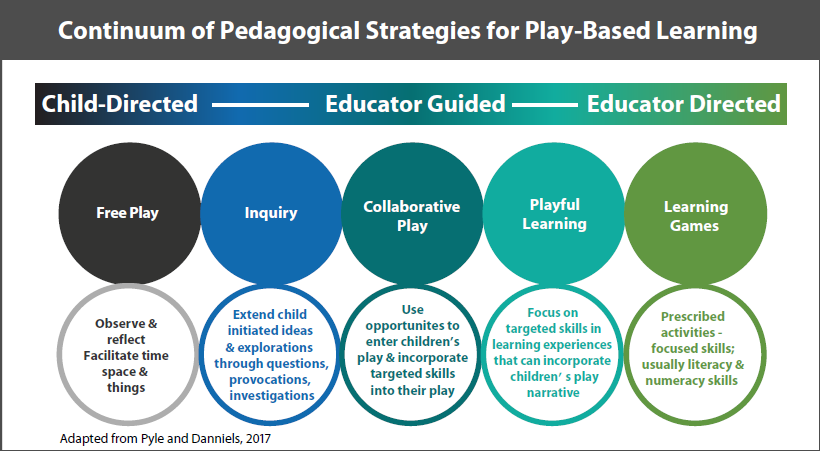
In their work around play, Pyle and Daniels created this continuum of play based learning strategies.
Free Play
Free play is the child-led play where children can choose what and where they want to play and they have no adult-directed learning intention or activity to complete. They choose to do it simply because they want to.
Inquiry Play
Inquiry play is where the stimulus and control is still very much from the children. It is their wonderings and exploration that starts the learning but the adult observes and will assist their learning without taking over. For example if a group of children were interested in seeing how far they could make their cars go, the adult might provide provocations like ramps, different size vehicles, measuring apparatus etc. They might provide oral wonderings or problems, or voice what has been discovered. This will help deepen the exploration and learning but it wasn’t planned in advance by the teacher it came from what the children were doing.
Collaborative Play
This type of play is where the lead is shared between the adult and child. The adult might have in their mind that they want to provide more opportunities for a certain skill or learning outcome e.g. mark making. They might talk to the children after reading a story as a stimulus, about how they would like to set up a post office role play area. They would then work with the children to discuss how the area would look, what should be included etc. The children might even use junk modelling to help set up the till or make the post box etc. The children will then naturally be playing in this area and writing letters or envelopes etc. just as the adult had wanted them to, but they were not told they had to do it, it was just part of the situation they had created collaboratively.
Playful Learning
Playful learning is where the adult finds a playful way to encourage children to practise the skills or deepen their knowledge of concepts. An example might be if children are struggling with one to one correspondence when counting but they like playing in the shop. The adult can model counting out the coins to pay the child or counting out the change. Once the adult had modelled this type of play the children will naturally repeat it. Or they could be going to stock up and ask the child to put 5 toys on the shelf etc. and help them to check.
Learning Games
Learning games are the most structured strategy as their is little room for creativity or choice but many games are still great fun for children and they enjoy playing them. Adding in the learning element e.g. common word bingo or number matching dominoes can be a useful addition, as long as they are used as part of the continuum and not the only type of play available.
Skilled Adult Intervention
Pyle and Daniel’s research showed the powerful learning opportunities that happened in the Inquiry and Collaborative approaches in particular. The learning started as free play, where children were free to explore and lead their learning but an adult was able to observe and then scaffold and extend their learning, not by taking over, but by guiding their inquiry, providing additional provocations, posing problems, working collaboratively to provide meaningful opportunities to develop skills etc. So whilst child-led, free play, should be a key feature of the balance of learning contexts, the adult still has an important role in observing and enhancing the learning that the children began.
